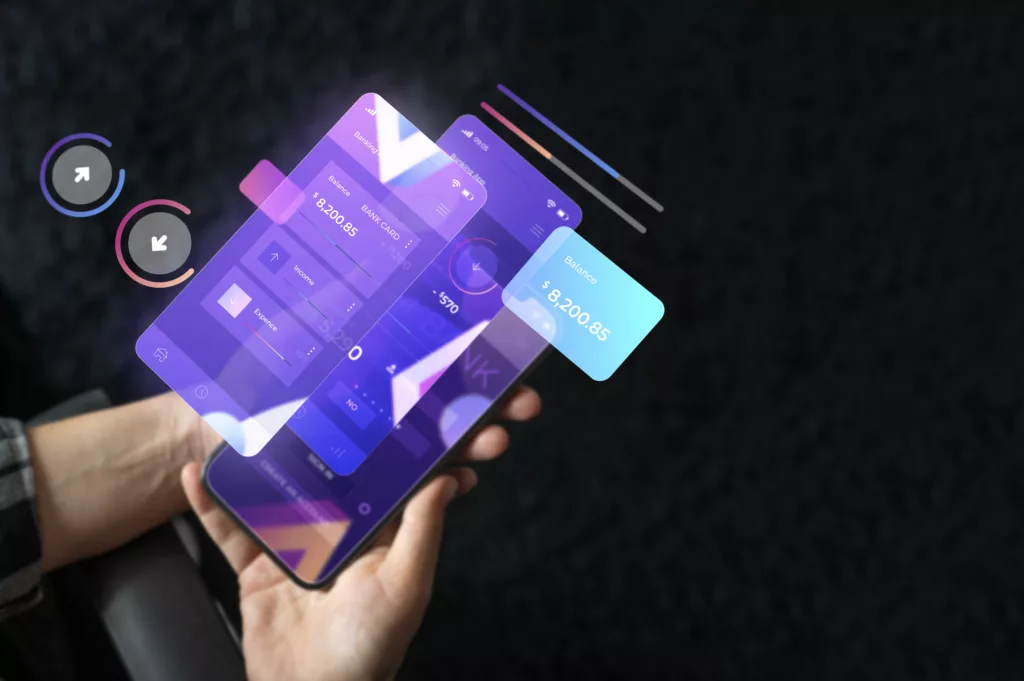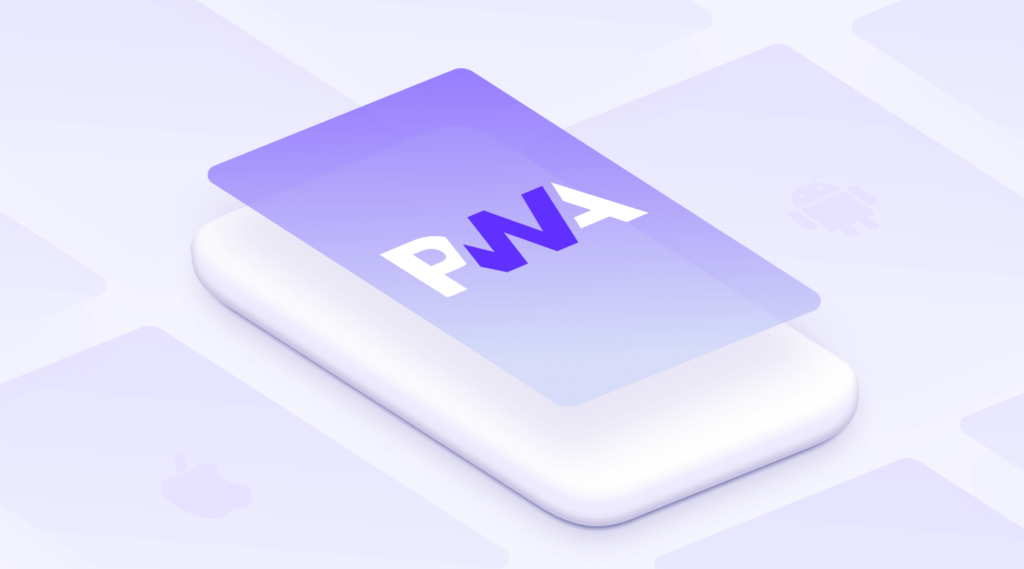Progressive Web Apps (PWAs) are revolutionizing the way we interact with digital content. With a staggering growth rate of over 30% annually, the PWA market is expected to reach a value of $10.77 billion by 2027.
PWAs offer a unique blend of web and native app features, delivering a seamless and engaging user experience. Let’s explore PWAs, PWA development, what is so special and why they’re rapidly gaining popularity.

Table of Contents
What is a Progressive Web App (PWA)?
A Progressive Web App (PWA) is a type of website that leverages modern web technologies to deliver a native app-like experience. Unlike traditional website development services, PWAs offer enhanced performance, offline functionality, and push notifications, making them a compelling choice for businesses seeking to engage users across devices.
Starbucks is a good progressive web app example. Their mobile-friendly website offers a seamless ordering experience, allowing customers to browse the menu, customize their drinks, and place orders without downloading a separate app.
The Starbucks PWA delivers a range of benefits:
- Offline Functionality: Users can access the menu and place orders even when their internet connection is unreliable.
- Push Notifications: Receive timely updates on order status and promotions.
- Fast Load Times: Enjoy a lightning-fast experience, reducing wait times and improving user satisfaction.
- Compact Size: PWAs are significantly smaller than native apps, saving device storage space.
By leveraging the power of PWAs, Starbucks has provided customers with a convenient and engaging digital experience.
Key Features of Progressive Web Apps (PWA)
1. Responsive Design:
Progressive Web Apps (PWAs) are designed to adapt seamlessly to various screen sizes and devices, ensuring a consistent and optimal user experience. Unlike traditional websites that may appear distorted or difficult to navigate on smaller screens, PWAs automatically adjust their layout and content to fit the specific device being used. This responsiveness enhances user satisfaction and engagement.
- Example: Airbnb
- Industry: Hospitality
- Key Features: Airbnb’s PWA features interactive maps and a seamless booking process. Travelers can explore listings and make reservations without the need for a native app.
2. Offline Capabilities:
PWA development aims to leverage service workers, a type of background script, to cache essential resources like images, scripts, and styles. This enables them to function offline, providing users with a seamless experience even when their internet connection is unreliable.
- Example: Starbucks:
- Industry: Food & Beverage
- Offline Sip: Starbucks’ PWA allows you to browse their menu and order drinks and food—even when you’re offline. Imagine being in a cozy corner of a café with weak Wi-Fi, but fear not! You can still decide between that caramel macchiato or a matcha latte.
3. App-Like Experience:
PWAs deliver a seamless and intuitive user experience, rivaling that of native apps. With features like smooth animations, swish gestures, and intuitive navigation, PWAs offer a delightful and engaging interface.
Furthermore, the ability to add PWAs to your device’s home screen provides a familiar and convenient access point, making them feel like native apps without the need for installation. This enhanced user experience can lead to increased engagement, satisfaction, and loyalty.
- Example: Flipboard:
- Industry: News & Content Aggregation
- Key Features: Flipboard’s is a good progressive web app example, offering a rich reading experience, combining the best of native apps with the reach of the web. Users can flip through articles, customize their content, and enjoy smooth animations—all within the browser. Flipboard’s PWA ensures a consistent and delightful reading experience across devices, whether you’re on a phone, tablet, or desktop.
4. Fast Loading:
PWAs offer a superior user experience by combining the best of both worlds: the accessibility of websites with the performance and features of native apps. In terms of PWA development, their responsive design, offline capabilities, app-like interface, and lightning-fast loading times make them a compelling choice for businesses seeking to engage users and drive conversions.
- Example: Weather.com:
- Industry: Weather Information
- Key Features: Weather.com’s PWA provides real-time weather updates. Even on slow internet connections, this PWA loads quickly and offers a smooth, consistent user experience. When you need to check the forecast, waiting isn’t an option. Weather.com ensures you get the info you need ASAP!
5. Secure:
PWAs prioritize security by requiring HTTPS, a protocol that encrypts data transmitted between the user’s device and the server. This ensures data integrity and protects against unauthorized access, providing a secure and trustworthy user experience.
Additionally, HTTPS enables the use of service workers, which play a crucial role in enhancing PWA functionality. Service workers can cache content, implement push notifications, and even function offline, further improving the overall security and reliability of PWAs.
- Example: Uber:
- Industry: Ride-Hailing
- PWA Features: Uber optimized its PWA for speed and reliability, ensuring a smooth booking experience. Uber’s PWA also uses HTTPS, securing communication between riders, drivers, and the Uber servers. Even in areas with poor network connectivity, users can book rides via the PWA. Trust is crucial in ride-hailing services. Uber’s secure PWA ensures that sensitive trip details remain confidential.
Differences Between PWA and Native Apps
Native app development involves creating separate versions for different OSs (e.g., Android and iOS). However, cross-platform frameworks (like Flutter or React Native) allow developers to write code once and deploy it on multiple platforms.
| PWAs | Native Apps: | |
| Installation | Installing a PWA is as simple as opening your browser and visiting the PWA’s website. No app store required. It’s like inviting a friend over without sending a formal invitation. | These apps demand a more formal process. You head to the app store (Google Play Store for Android or Apple App Store for iOS), search for the app, and hit that “Install” button. It’s like adopting a pet—you commit to a download. |
| Updates | They’re the low-maintenance pals. PWAs update automatically in the background. No annoying notifications or manual intervention. It’s like having a self-watering plant—always fresh. | These need your attention. When an update is available, you get a nudge: “Hey, there’s a new version!” You tap “Update,” and the app spruces up. It’s like tending to a high-maintenance bonsai tree. |
| Platform Independence | They’re globe-trotters. PWAs work on any platform with a modern browser—Windows, macOS, Android, iOS, even that ancient desktop in your grandma’s attic. It’s like speaking a universal language. | These are picky eaters. They’re specific to their platform—iOS apps for iPhones, Android apps for, well, Android. It’s like regional cuisine—delicious but limited to certain places. |
| Discoverability | Discovering PWAs is like finding hidden treasure. They rely on web search, direct links, or recommendations. No app store spotlight. It’s like stumbling upon a secret garden. | These thrive on app store visibility. Users browse categories, read reviews, and choose apps like they’re shopping. It’s like browsing a bustling marketplace. |
Essential Requirements for Developing a PWA
When creating a PWA, there are several key aspects to consider to ensure a successful and user-friendly experience:
1. Technology Stack:
- Frontend Magic: PWAs start with the basics. You’ll need HTML (the skeleton), CSS (the stylist), and JavaScript (the wizardry). These three conjure up your PWA’s user interface.
- Modern Frameworks: Want to turbocharge your PWA? Leverage modern frameworks like React, Angular, or Vue.js. They’re like power tools for developers—efficient and reliable.
- Backend APIs: Your PWA needs a backstage crew. Ensure your backend (the server-side stuff) provides the necessary APIs. Think of APIs as the secret passages connecting your front end to data and functionality.
2. HTTPS:
- The Padlock Protocol: PWAs are security-conscious. They demand HTTPS—the little padlock in your browser’s address bar. Why? Because it guarantees data integrity and keeps the digital baddies at bay.
- Service Worker Enabler: HTTPS also unlocks the service worker feature. It’s like giving your PWA a backstage pass—it can cache resources, handle push notifications, and work offline.
3. Application Shell:
- The Instant Load Zone: The application shell loads instantly. It’s the minimal HTML, CSS, and basic functionality that appears immediately.
- Dynamic Content: Once the shell is in place, additional content can be loaded dynamically. It’s like revealing more layers of the PWA as users explore.
4. Service Worker:
- Background Sorcery: The service worker is your PWA’s behind-the-scenes hero. It’s a JavaScript file that runs in the background, even when users close the tab.
- Caching Spells: Service workers cache resources—images, scripts, styles—so your PWA can still function offline. It’s like having emergency supplies in a survival kit.
5. Manifest File:
- PWA Passport: Create a manifest.json file. It holds essential metadata.
- What’s Inside?: Name, icons (those little app symbols), theme color (because aesthetics matter). Browsers treat your PWA more seriously when it has this manifest.
6. Application Testing:
- Quality Assurance: Test, test, test! Try your PWA on different devices (phones, tablets, laptops), browsers (Chrome, Firefox, Safari), and network conditions (fast Wi-Fi, slow 3G).
- Offline Adventures: Verify how your PWA behaves when the internet ghosts you. Does it still load? Can users access critical features? It’s like rehearsing for unexpected plot twists.

Step-by-Step Guide to Building a Progressive Web App (PWA)
So, how exactly do you create progressive web apps? Here are 5 steps you need to go through to set up a basic PWA project
Step 1: Set Up Your Project:
- Create a New Project Folder: Imagine this as your PWA’s cozy home. Choose a name, create a folder, and make it feel welcoming.
- Initialize with Necessary Tools: Think of this as unpacking your toolkit. Use npm or yarn (the handy assistants) to set up your project. They’ll fetch all the necessary tools and dependencies.
Step 2: Build the Application Shell:
- HTML File for the Shell: The application shell is like the outer frame of your PWA. Create an HTML file—a blank canvas. It’s the lobby of your theater, ready to welcome visitors.
- Add Basic Styles and Layout: Dress up your lobby! Add some CSS (styles) and layout elements. Make it visually appealing, even if it’s just the essentials.
Step 3: Implement Service Worker:
- Service Worker Script: Meet your backstage crew—the service worker. Write a JavaScript file that runs in the background. It’s like the stage manager, ensuring everything runs smoothly.
- Register in Your HTML File: Invite the service worker to the party. In your HTML, register the service worker. Now it’s officially part of the team.
- Handle Caching and Offline Behavior: The service worker caches resources—images, scripts, styles. So when the internet takes a break, your PWA can still perform. It’s like having emergency lights during a power outage.
Step 4: Create a Manifest File:
- Manifest.json: This is your PWA’s ID card. Create a manifest.json file. Inside, define metadata: the app’s name, icons (those little symbols), and even its theme color. Browsers treat your PWA more seriously when it has this manifest.
Step 5: Test and Optimize:
- Quality Assurance: Put your PWA through its paces. Test it on various devices (phones, tablets, laptops) and browsers (Chrome, Firefox, Safari). Make sure it behaves well.
- Offline Adventures: Unplug your Wi-Fi and see how your PWA handles it. Does it still load? Can users access critical features? It’s like rehearsing for unexpected plot twists.
- Optimize Performance and Responsiveness: Trim the excess. Prioritize what matters—essential content. Lazy-load non-critical stuff. Make your PWA nimble and delightful.
Conclusion:
PWAs are the future—a blend of web accessibility and app-like functionality. Here’s why you should consider them:
And where should you turn for top-notch PWAs? Look no further than Vinova! Our expertise, tailored solutions, and results-driven approach make them the go-to choice to create progressive web apps.
Ready to transform? Vinova’s got your back. Let’s build something extraordinary together!